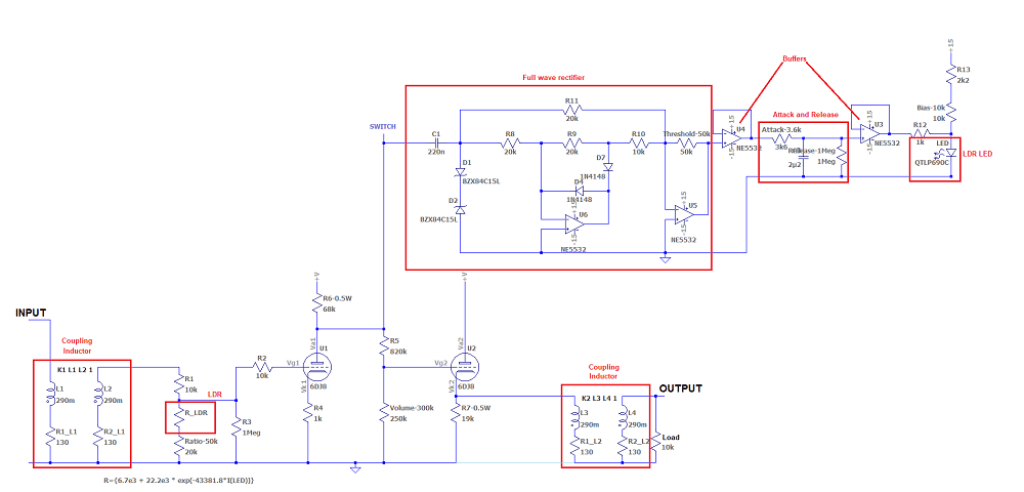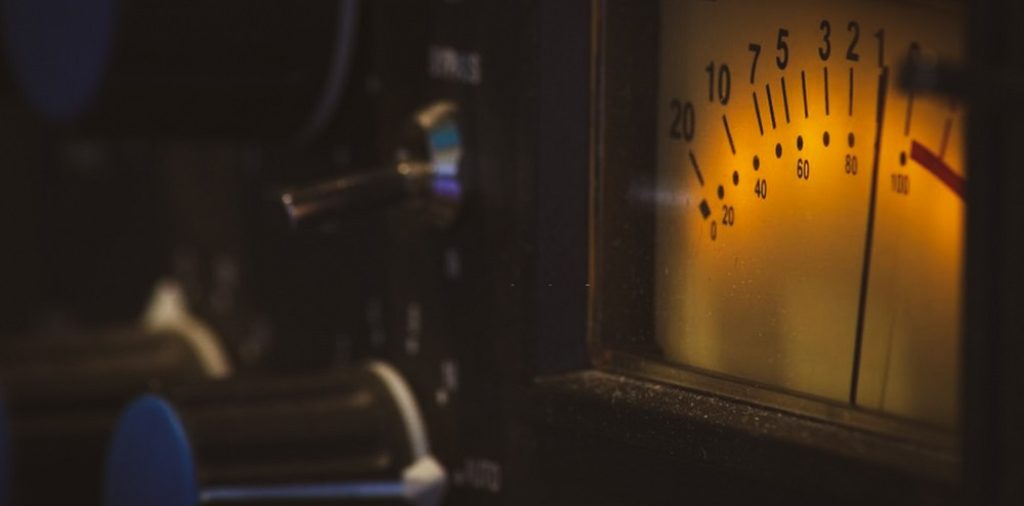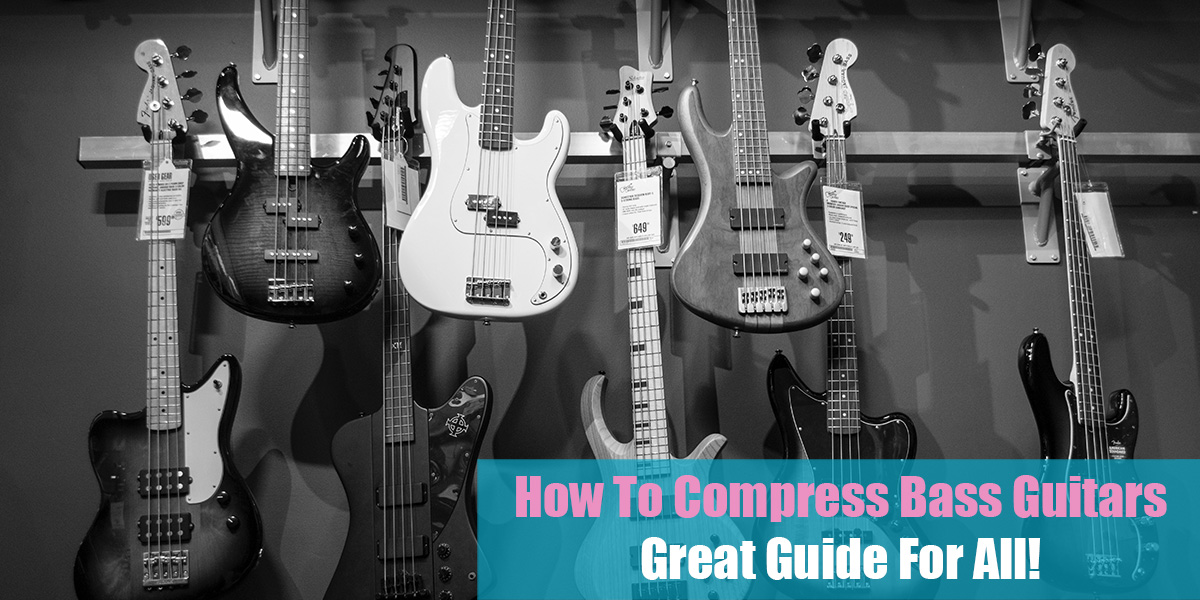What Are Optical Compressors?
Introduction
On our way to audio mastery, we should understand the optical compressor (or plugin emulation) as one of the most common hardware compressors.
How do optical compressors work? An optical compressor alters the dynamics of an audio signal by using a light element and an optical cell. By emitting more light, the light element attenuates the output signal’s amplitude as the audio signal increases.
It is fairly simple to construct an electro-optical attenuator. A typical compressor splits the incoming audio signal into two parts: the part which passes through the gain stage and is ultimately output, and the part which functions as a detector circuit to control the gain stage. The unique aspect of this detector circuit lies in its construction.
Control of the gain reduction is achieved through the use of a light source and sensor. Because of the unique properties of these devices, the gain cell reacts in a way that has not been possible to replicate with conventional components until recently.
In most cases, this is due to certain time lags occurring within the compressor, which results in very pleasing attack and release characteristics that engineers prefer over other types of compressors.

An optical compressor can utilize a standard incandescent light source, however, due to thermal inertia, there is a significant delay between the moment the input voltage is applied to the filament and the moment it begins to glow.
You may also use a fluorescent light bulb, but the light intensity does not vary strictly as a function of the voltage input. Electroluminescent sources are used instead in most circuits.
A capacitor-like electroluminescent source is constructed from two conductive plates separated by a small gap; it reacts very rapidly, allowing fast attack times for a compressor, and glows in direct proportion to the input voltage, providing predictable attenuation. A special type of LED is used in some modern designs.
A gain reduction circuit for an optical compressor may, however, utilize any of the following light sources:
- LED stands for light-emitting diode. LEDs are semiconductor diodes that emit light when a voltage is applied. It is not uncommon for Opto compressor LEDs to be designed in order to provide specific characteristics of attack, release, and voltage-to-brightness.
- A device utilizing electroluminescent emission consists of two conductive plates separated by a small gap (similar to a capacitor). Fast attack times and direct proportional brightness are characteristics of electroluminescent devices.
- The fluorescent bulb is a low-pressure mercury vapor gas discharge lamp that produces light by fluorescence. The input voltage and brightness of fluorescent bulbs are not linear.
- There is an incandescent bulb, which emits light through the heating of its filament. There is a slow reaction time between brightness and input voltage as a result of thermal inertia.
What are Opto Compressors Good for?
Opto compressors have a reputation for smoothing out audio without reducing transients and helping with a better-fitting track in the mix with minimal color.
For example, you would not get a great result if you attempted to control short, sharp transients using a VCA, but you would be able to produce smooth compression at much higher ratios. In addition to creating a more pleasant sound, the smoother response will also prevent a dramatic squashing of the signal.
An Opto compressor reacts best to an RMS signal if you are familiar with peak and RMS options in your DAW.
An RMS display represents the average of the signal, while a Peak display represents the peaks. This makes it easier to understand how an Opto operates. It is also possible to incorporate an element of coloring into your sound with Opto compressors.
It is common to use optical audio compressors in recording and live sound settings to even out the dynamic range of an audio signal and to enhance its clarity, sustain, and punch. A variety of instruments, such as vocals, drums, bass, and others, are often used to achieve these effects.

The use of optical compressors in the recording studio can be used during the tracking or mixing stages as well as on the mix bus when adding overall glue and punch to a mix. As well as taming transient-heavy sources such as drums and percussion, they can also enhance vocals and other instruments with sustain and clarity.
Optical compressors are useful in live sound settings to improve the clarity and punch of the sound by controlling the dynamic range compression and enhancing individual instruments within the monitor mix. It is also common to use them on vocals in order to enhance their ability to cut through the mix and be clearly heard.
A compressor is an effective tool for shaping the dynamics of an audio signal and improving the overall sound quality in various recording and live sound situations.
We just want to let you know that we’ll list these best Opto compressors in no particular order. They’ll be randomized as we don’t wish to sort them from best to worst.
Listed below are our Top 5 Opto Compressors of all time:
1. Universal Audio Teletronix LA 2A
The Teletronix LA-2A, in its hardware form, was widely recognized for its gentle, musical compression. A plug-in version of the LA-2A is available from Universal Audio in three distinct flavors – the well respected ‘Silver’ version from the late 60s, the ‘Gray’ version from the mid-60s, and the ultra-rare LA-2 from the early 60s.
If you do not already own the original LA-2A plugin version, you will be pleased to learn that you will also receive authorization for the legacy version, which is arguably still of value despite its lighter DSP usage.
This is arguably the polar opposite of the flexibility provided by a VCA compressor with chameleon-like characteristics, which is what makes the hardware Teletronix LA-2A unique.
It consists of two knobs: Peak Reduction, which acts as a threshold control, and Gain, which raises the signal back to unity after compression. This is enough when you need to adjust the input signal and level out the output signal as well.
In our opinion, this is probably one of the best optical compressors that are widely used when people are reaching out for optical compression.
- 0dB to 40dB gain limiting
- Balanced XLR input and output
- Frequency response 30Hz-15kHz (+0/-1dB)
- Output level: 10dBm; Gain: 40dB
- Low noise: 70dB below +10dBm output level
- Handcrafted in UA’s Scotts Valley, California labs

| IMAGE | PRODUCT | For US Customers |
|---|---|---|
Universal Audio Teletronix LA 2A |
2. Heritage Audio Tubesessor Optical Tube Compressor
Heritage Audio is already known for creating some amazing units when it comes to studio usage, recording, and tracking. We already reviewed this amazing unit already and we will be sharing some of the stuff we learned about this one.
Aside from being ideally suited to warm up and subtly enhancing a signal while maintaining total dynamic control, Tubesessor also has a few useful tricks hidden within its 3U rackmount enclosure.
In terms of tubes, the Tubesessor’s most innovative feature is the Tube Saturation knob, which uses a NOS Raytheon CK5755 double triode tube. The saturation can be adjusted to four different levels, namely Classic, Mild, Medium, and Hot.
Additionally to the standard controls for threshold (off to -40), ratio (2:1 to 10:1), attack (fast or slow), release (fast or slow), and gain (up to +30dB), you will also be able to select a side-chain option with five options.
- Gain: -10 to +30 dB
- Ratio: 2:1 to 10:1
- Threshold: 10 to -40 dB
- Adjustable output level
- Dimensions (W x H x D): 482 x 134 x 153 mm
- Weight: 3.364 kg

| IMAGE | PRODUCT | For US Customers |
For EU Customers |
Amazon Store |
|---|---|---|---|---|
Heritage Audio Tubesessor |
Check our full product review on the Tubesessor here!
3. Tube-Tech CL 2A 2-channel Tube Optical Compressor
A Tube-Tech CL 2A Dual Compressor is equipped with two independent optical compressors. A tube-based output amplifier with a +10 dB gain is placed after the optical gain reduction element, followed by the input transformer.
Whenever two separate compressors are to be used in stereo mode or several compressors are to be linked together, a switch with three positions (Link 1, Off, Link 2) is used. Both link buses are identical.
The input and output transformers are both fully floating with a static screen on both sides. Solid-state circuits are used for the power supply and the sidechain signal circuit. DC voltages are stabilized except for the anode voltage at the output stage.
In fact, it is one of the most sought-after units among engineers, producers, and artists for its ability to allow a track to sit well in a mix without losing its clarity regardless of the level of compression applied.
Many of the top rap and hip-hop vocalists utilize it as their primary compressor, but it also works well in any musical setting. It is virtually impossible to produce a bad sound with this compressor; in addition to that, its straightforward operation makes it a favorite among users as well.
- Optical gain reduction element
- Channels for linkable stereo operation
- Dual VU meters for indicating output level or compression
- Adjustable output level
- Frequency response: 5 – 60,000 Hz
- Noise-free bypass via relay

| IMAGE | PRODUCT | For US Customers |
For EU Customers |
|---|---|---|---|
Tube-Tech CL 2A 2-channel Tube Optical Compressor |
4. Manley VOXBOX
Even though the VOXBOX is a channel strip unit, the Opto compression that it offers performances that every audio engineer wants. If you want some smooth harmonic distortion and really nice features with transparent sound, the VOXBOX is the right unit for you.
In addition to being your “last stop” for voice processing, the Manley Labs VOXBOX is also set up to maximize virtually any source you send its way. The VOXBOX features the same fully-featured microphone preamplifier as Manley’s widely acclaimed Mono Microphone Preamplifier, offering plenty of headroom and the warmth of Class A vacuum tubes.
Additionally, the smooth compressor section combines Manley’s best-selling Variable MU with their Opto-Design ELOP. The VOXBOX offers all of these features, as well as a Pultec-style mid-frequency equalizer, a de-esser/limiter section, and stereo link functionality.
You have an impressive piece of gear with great versatility when you add Manley’s state-of-the-art design specifications. VOXBOX is not only a vocal processor, but also works wonders on instruments, including drums, bass, guitars, keyboards, etc. It is hard to find a better audio processor than the VOXBOX, which is highly regarded in the audio community around the world.
- 1-Channel tube preamp with electro-optical compressor
- De-esser/limiter L2A character
- 3-Band tube Pultec EQ
- Transformer-balanced XLR outputs
- VU meter
- +48 V phantom power

| IMAGE | PRODUCT | For US Customers |
For EU Customers |
Amazon Store |
|---|---|---|---|---|
Manley VOXBOX |
5. ART Pro VLA II
The two-channel Pro VLA II is constructed in a 2U rack chassis and features an elegantly sculpted front panel with two large, backlit analog VU meters.
Below are separate LEDs that indicate the amount of gain reduction that is being achieved by the compressor. In addition, LED meters located in the center of the unit display both the average and peak output levels, with the peak LED holding its value for a short period of time.
There are both XLR and quarter-inch TRS balanced inputs and outputs, with switchable +4dBu or -10dBu levels for connecting to systems operating at either level.
In addition, both inputs and outputs have enough headroom to operate up to +20dBu when the +4dBu setting is selected. When there is a stereo link button, the compressor can either function as two separate mono compressors or as a stereo compressor.
In both channels, there are small attack and release controls positioned above the threshold, ratio, and output-level knobs. It is always necessary to set the attack and release manually, there is no automatic mode.
In addition, there is no ‘mix’ or ‘blend’ knob for managing parallel compression. While this is not an essential feature, we expect to see it on more hardware compressors in the near future.
- Adjustable threshold
- Ratio and Attack
- + 4dBu/-10 dBu mode switchable
- Backlit VU meter
- LED meter for peak hold
- Balanced XLR and 6.3 mm inputs and outputs

| IMAGE | PRODUCT | For US Customers |
For EU Customers |
Amazon Store |
|---|---|---|---|---|
ART Pro VLA II |
Conclusion
Well, we tried to cover some of the basics of how audio signals are treated when they go via Opto compressors and we provided some models that you can get and avoid any worries if you are getting the right unit or not.
Nowadays, you will be able to find many audio compressor plugins as well that will treat the signal as if it goes through the Opto circuits.
In our humble opinion, people are mostly using Opto as they are one of the most famous compressor types around. The compressed signal is smooth and works really well on bass frequencies as well.
In case you are having any questions in regards to this topic or the units we shared in this article, please let us know in the comment section below and we will be more than happy to provide additional explanation.






